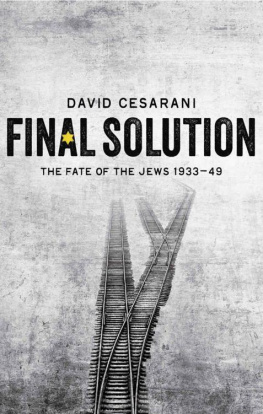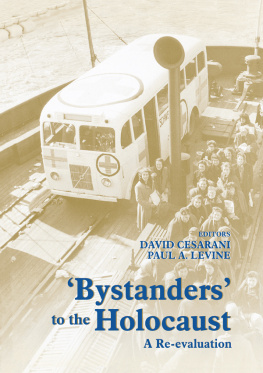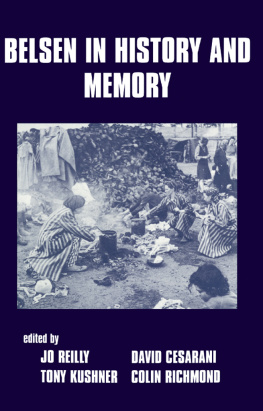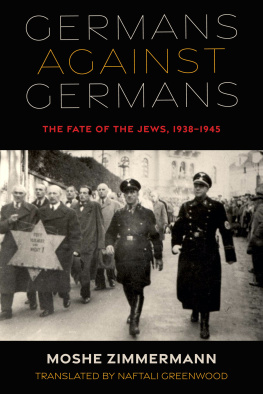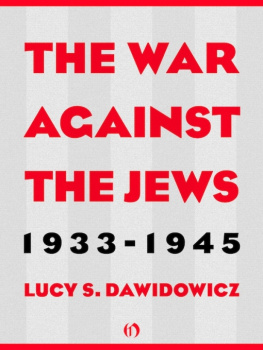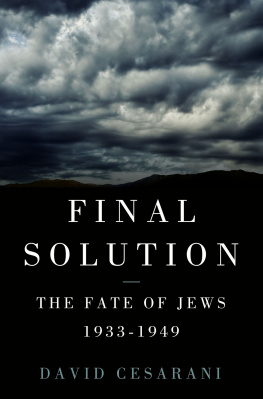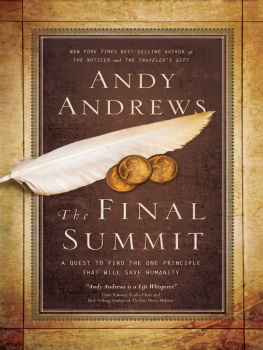David Cesarani - Final Solution: The Fate of the Jews 1933-1949
Here you can read online David Cesarani - Final Solution: The Fate of the Jews 1933-1949 full text of the book (entire story) in english for free. Download pdf and epub, get meaning, cover and reviews about this ebook. year: 2016, publisher: Macmillan, genre: History. Description of the work, (preface) as well as reviews are available. Best literature library LitArk.com created for fans of good reading and offers a wide selection of genres:
Romance novel
Science fiction
Adventure
Detective
Science
History
Home and family
Prose
Art
Politics
Computer
Non-fiction
Religion
Business
Children
Humor
Choose a favorite category and find really read worthwhile books. Enjoy immersion in the world of imagination, feel the emotions of the characters or learn something new for yourself, make an fascinating discovery.
- Book:Final Solution: The Fate of the Jews 1933-1949
- Author:
- Publisher:Macmillan
- Genre:
- Year:2016
- Rating:4 / 5
- Favourites:Add to favourites
- Your mark:
- 80
- 1
- 2
- 3
- 4
- 5
Final Solution: The Fate of the Jews 1933-1949: summary, description and annotation
We offer to read an annotation, description, summary or preface (depends on what the author of the book "Final Solution: The Fate of the Jews 1933-1949" wrote himself). If you haven't found the necessary information about the book — write in the comments, we will try to find it.
Final Solution: The Fate of the Jews 1933-1949 — read online for free the complete book (whole text) full work
Below is the text of the book, divided by pages. System saving the place of the last page read, allows you to conveniently read the book "Final Solution: The Fate of the Jews 1933-1949" online for free, without having to search again every time where you left off. Put a bookmark, and you can go to the page where you finished reading at any time.
Font size:
Interval:
Bookmark:
DAVID CESARANI
FINAL SOLUTION
THE FATE OF THE JEWS 193349
MACMILLAN
CONTENTS
Maps



List of Illustrations
Section One
Section Two
Section Three
Acknowledgements
: courtesy of the Wiener Library, London
: Yad Vashem
: courtesy of the Leo Baeck Institute
: Collection Jewish Historical Museum, Amsterdam
: Erling T. Hofmo/NTB scanpix
: Aufbau-Verlag/ullstein bild via Getty Images
: Mmorial de la Shoah/Coll. Mariette Job
: United States Holocaust Memorial Museum, courtesy of Mary Berg
: Adam Czerniakow. / Forum / Bridgeman Images
: United States Holocaust Memorial Museum
: sourced from the YIVO Institute
: Paul Popper/Popperfoto/Getty Images
: United States Holocaust Memorial Museum, courtesy of Trudi Gidan
: akg-images / Bildarchiv Pisarek
: Keystone-France\Gamma-Rapho via Getty Images
: Roger-Viollet/REX Shutterstock
: Mondadori Portfolio via Getty Images
: Jewish Historical Institute
First and foremost I would like to thank my agent, Peter Robinson, without whose unstinting support and friendship this book would neither have been started nor completed. Georgina Morley has been a patient and understanding editor, whose suggestions made the finished product shorter and better. I must also thank Nicole Foster for copy editing, Nicholas Blake for overseeing production, and Martin Lubikowski for the maps.
The book has benefited from the staff and resources of the three great libraries and archives that cover its subject. At the United States Holocaust Memorial Museum in Washington, DC, I would like to thank Paul Shapiro, the director of the Centre for Advanced Holocaust Studies, Suzanne Brown-Fleming, Jrgen Matthus, and Martin Dean. During visits to the Centre, often unannounced and informal, Jrgen and Martin have generously given their time to discuss my work, answer questions, and offer suggestions. I am especially grateful to Jrgen, who shared with me the fruits of a major USHMM archival find, the diary of Alfred Rosenberg, before it was published. During a sabbatical at the USHMM I was able to meet Jeffrey Herf when he was completing his book about the place of the Jew and anti-Semitism in Nazi wartime propaganda. Jeffrey is both an ally and a stimulating colleague. At Yad Vashem in Jerusalem I was fortunate to have been able to spend time with David Bankier, head of the International Institute for Holocaust Research, before his untimely death. Dan Michmann, the current director of the Institute, has been a constant source of information and a challenging critic of my ideas. Rob Rozett, director of the Library, read an early version of the manuscript and made many wise comments, often drawing my attention to new publications in the field. David Silberklang, editor of Yad Vashem Studies, commissioned me to write a number of reviews and other pieces that have helped clarify my thinking on historiography; his editorial comments have always been valuable. Rob and David are also dear friends and have welcomed me, and my family, into their homes many times. One of the compensations for working on such grim material for so long is that over this time our families have come to know one another and our friendships have deepened. Thanks to my visits to Yad Vashem and also my involvement with the International Holocaust Remembrance Alliance (formerly the Task Force for International Cooperation on Holocaust Remembrance, Education and Research) I have also had the opportunity to discuss aspects of my work with Yehuda Bauer, whose fund of knowledge and insight is peerless. The Wiener Library in London has been an indispensable, local resource and I would like to thank its director, Ben Barkow, and the head librarian, Kat Hbschmann, for their hospitality and unfailing assistance. Needless to say, all three institutions would not function without many members of staff, too numerous to list: I would just like to say a big Thank You to all of them.
Aspects of this research have been presented in lectures and I would like to thank the organizers of these events and acknowledge the feedback they garnered. In 2011 as the Wilkenfeld Family Lecturer in Holocaust Education at the Sidney Jewish Museum I benefited from the advice and insight of my host, Konrad Kwiet. The following year, Milton Shain, director of the Kaplan Centre for Jewish Studies, University of Cape Town, invited me to an unusual gathering at the citys wonderful Jewish Museum at which Holocaust historians were invited to reflect on the autobiographical dimension of their work. Over the course of several days I enjoyed the company and conversation of Steven Aschheim, Doris Bergen, Christopher Browning, Richard J. Evans, Robert Erikson, Steven T. Katz, Michael Marrus, Antony Polonsky, and Karl Schleunes. Despite having met each other on various occasions in different circumstances, this was a particularly fruitful and reflective encounter. In 2014 I was invited to deliver the Raul Hilberg Memorial Lecture at the University of Burlington, Vermont. Francis Nicosia and Jonathan Heuner were perfect hosts, but they also made valuable observations on my paper attempting to bring together the history of the war and the fate of the Jews. Jerold D. Jacobson, who generously supports the lecture series, proved an incisive critic as well as a jolly dinner companion. Jacques Fredj, director of the Mmorial de la Shoah in Paris, has invited me to address audiences there on several occasions, which has also given me the opportunity to use the resources of the centres library and archive. Our post-lecture conversations at a restaurant around the corner are always a highlight of these visits. In 2015, Guri Schwarz enticed me to a conference on remembrance of the Holocaust held at the new Memoriale della Shoah in Milan. This gave me the chance to explore the bleak, subterranean freight yard from which over a thousand Italian Jews were deported. The participants in the conference included Tal Bruttmann, whose path-breaking research earlier led me to revision the plight of Jews during the last phase of the German occupation of France. A few months later, at the invitation of Antony Polonsky, I attended a three-day conference to mark the opening of the permanent exhibition of Polin the new museum of Polish Jewish history in Warsaw. The conference heard from a cadre of Polish historians who, since 1990, have transformed the way we understand the fate of Polish Jews. The fruits of their research pepper the footnotes of this book. In this connection I would like to acknowledge the impact of publications and presentations by Jan T. Gross and Jan Grabowski, whom I had occasion to meet during their visits to London and elsewhere. Their pioneering and courageous work has had a huge influence on my approach to the subject. Finally, I would like to thank Stephen Feinberg, recently retired from the US Holocaust Memorial Museum, for inveigling me into educational events in Washington, Kaunus, and Budapest. Steve has been a superb sparring partner for many years and, once again, it mitigates the darkness of the subject to know that through it I became friends with him and his no less feisty partner, Patt Moser.
Next pageFont size:
Interval:
Bookmark:
Similar books «Final Solution: The Fate of the Jews 1933-1949»
Look at similar books to Final Solution: The Fate of the Jews 1933-1949. We have selected literature similar in name and meaning in the hope of providing readers with more options to find new, interesting, not yet read works.
Discussion, reviews of the book Final Solution: The Fate of the Jews 1933-1949 and just readers' own opinions. Leave your comments, write what you think about the work, its meaning or the main characters. Specify what exactly you liked and what you didn't like, and why you think so.

